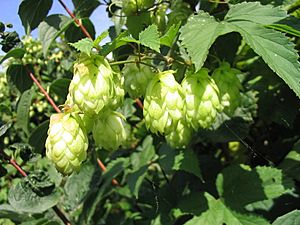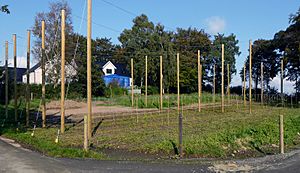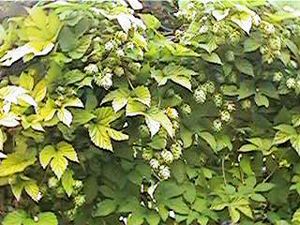Common hop facts for kids
Quick facts for kids Common hop |
|
|---|---|
 |
|
| Scientific classification | |
| Genus: |
Humulus
|
| Species: |
lupulus
|
| Synonyms | |
|
|
Humulus lupulus, also known as the common hop or just hops, is a type of flowering plant. It belongs to the hemp family. This plant naturally grows in Europe, western Asia, and North America.
Hops are a perennial plant, which means they grow back every year. They are also herbaceous, meaning they have soft stems instead of woody ones. Hops are a climbing plant that sends out new shoots in spring. In autumn, the plant dies back to its underground stem, called a rhizome, which can survive the cold winter. Hops are dioecious, meaning there are separate male and female plants.
The female cone-shaped flowers of the hop plant are called "hops." These are very important in making beer because they help preserve it and give it flavor. Because of this, the common hop is grown widely by the brewing industry.
Contents
What Hops Look Like
The common hop plant, Humulus lupulus, can grow up to 10 meters (about 33 feet) tall and can live for up to 20 years. Its leaves are simple and have 3 to 5 deep lobes. These leaves can grow opposite each other or in an alternating pattern along the stem.
Hops usually start to flower around July or August when the summer days get longer. As mentioned, the plant is dioecious, so male and female flowers grow on different plants. The flowers have a nice smell and are pollinated by the wind. Male flowers do not have petals. Female flowers have petals that wrap around the fruit. The female flower cones are what we call hops.
The fruit of the hop plant is a dry fruit called an achene. It does not split open when it is ripe. This fruit is surrounded by small leaf-like parts, and it has special glands that produce a substance called lupulin.
Sometimes, hops are called a "bine" instead of a "vine." This is because they have stiff, downward-pointing hairs that help them climb. These hairs give the plant stability as it grows upwards.
Hop Chemistry
Hops contain many interesting natural chemicals. Some of these include myrcene, humulene, xanthohumol, myrcenol, linalool, tannins, and resin.
Hops are special because they have unique chemicals called secondary metabolites, flavonoids, oils, and polyphenols. These chemicals are what give products like beer their distinct flavor. The bitter taste in hops comes from special acids. These acids greatly affect the taste of things made with hops.
Scientists have found many genes that influence the taste of hops. Over thousands of years, people have chosen and grown hop plants with the best smells and bitter tastes. This human selection has also helped create varieties that produce a lot of hops.
What Scientists Study About Hops
Scientists are always learning more about hops. Here are some things they have found:
- Hops contain a chemical called xanthohumol. When this chemical is processed by bacteria in the large intestine, it changes into another chemical called 8-prenylnaringenin. This chemical might act like estrogen in the body.
- Extracts from Humulus lupulus can fight germs. This is why they have been used in natural deodorants.
- Even the leftover parts of hops from brewing can fight germs and stop biofilms (sticky layers of bacteria) from forming. This means these waste products might be useful for new medicines.
- Extracts from the bitter acids in hops have been shown to help people sleep better by reducing activity at night, if used in the right amounts.
Scientists are also looking into how hops are similar to other plants that produce helpful compounds, like cannabidiol. This research could help us discover more unknown benefits in hops.
How Hops Are Classified

There are five main types, or varieties, of the common hop species (Humulus lupulus):
- H. l. var. lupulus – Found in Europe and western Asia.
- H. l. var. cordifolius – Found in eastern Asia.
- H. l. var. lupuloides (also called H. americanus) – Found in eastern North America.
- H. l. var. neomexicanus – Found in western North America.
- H. l. var. pubescens – Found in the midwestern and eastern parts of North America.
Many different kinds of hops are grown by farmers. You can find a long list of hop varieties. There's also a special type called Humulus lupulus 'Aureus', or 'Golden' hop, which has yellow leaves. People grow it in gardens because it looks nice. It has even won an award called the Royal Horticultural Society's Award of Garden Merit.
Where the Name Comes From
The name of the hop plant, Humulus, comes from a very old medieval name. It was likely borrowed from a Germanic language.
The second part of the name, lupulus, is Latin for "small wolf." This name was given because the hop plant tends to grow over and "strangle" other plants, especially willows, much like a wolf might attack a sheep. People often saw hops growing all over these willows, so they called it the "willow-wolf."
The English word "hop" comes from the Middle Dutch word hoppe, which also means Humulus lupulus.
Where Hops Grow
The common hop plant is naturally found in Europe, western Asia, and North America.
It grows best in areas between 38° and 51° latitude. It needs full sun and a moderate amount of rainfall to thrive.
Hops and Nature
Hop flowers attract many insects, including butterflies.
Animal Pests
Like many plants, hops can be affected by certain pests:
- Damson hop aphid (Phorodon humuli)
- Two spotted spider mite (Tetranychus urticae)
- Japanese beetle (Popillia japonica)
- Comma butterfly (Polygonia c-album)
- Pale tussock moth (Calliteara pudibunda)
- Currant pug moth (Eupithecia assimilata)
- Buttoned snout moth (Hypena rostralis)
- Buff ermine moth (Spilosoma lutea)
Plant Diseases
Hops can also get certain diseases:
- Downy mildew (Pseudoperonospora humuli)
- Powdery mildew (Podosphaera macularis)
Is it Harmful?
Handling hops can cause a skin rash called dermatitis in some people. It's thought that about 1 out of every 30 people might be affected this way.
How Hops Are Used
The common hop was first mentioned in the year 768 CE. At that time, King Pepin gave hops to a monastery in Paris. The first time hops were recorded as being grown on purpose was in 859 CE, in documents from a monastery in Freising, Germany.
The chemicals found in Humulus lupulus are the main ingredients that give beer its flavor and bitter taste. The fragrant flower cones, or hops, add a bitter flavor and also help preserve the beer. Some other chemicals in hops help create the foam on top of beer. Chemicals like linalool and aldehydes also add to beer's flavor. The main bitter taste in beer comes from chemicals called iso-alpha acids.
Before the Middle Ages, another plant called Myrica gale was commonly used to flavor beer. But then, Humulus lupulus became popular because it contains natural preserving agents. These agents help beer last longer.
Hops in Culture
In 2002, the common hop was chosen as the county flower of Kent in the United Kingdom. This was decided after a public poll held by a charity that protects wild plants called Plantlife.
See also
 In Spanish: Lúpulo para niños
In Spanish: Lúpulo para niños


